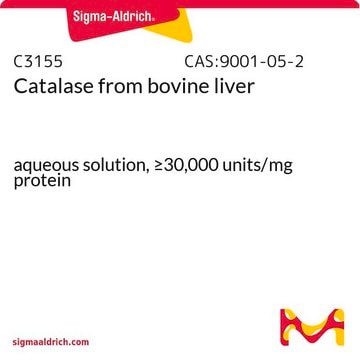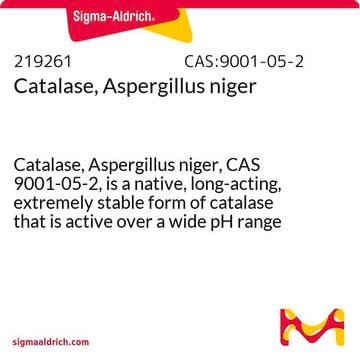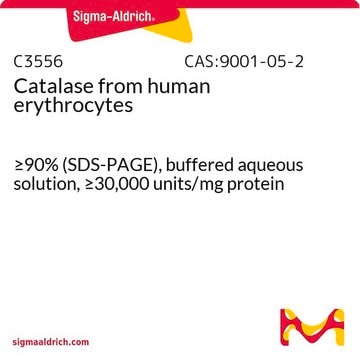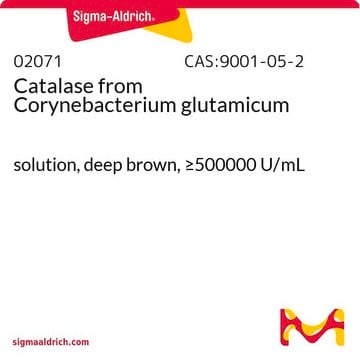C30
Catalase from bovine liver
aqueous suspension, 10,000-40,000 units/mg protein
Sinonimo/i:
Bovine hepatocatalase, H2O2:H2O2 oxidoreductase
About This Item
Prodotti consigliati
Origine biologica
bovine liver
Forma fisica
aqueous suspension
Attività specifica
10,000-40,000 units/mg protein
PM
tetramer ~250 kDa
Concentrazione
20-50 mg/mL
tecniche
GC/MS: suitable
Punto isoelettrico
5.4
N° accesso UniProt
Condizioni di spedizione
wet ice
Temperatura di conservazione
2-8°C
InChI
1S/C9H10O3/c1-2-12-9(11)7-3-5-8(10)6-4-7/h3-6,10H,2H2,1H3
NUVBSKCKDOMJSU-UHFFFAOYSA-N
Informazioni sul gene
cow ... CAT(280743)
Cerchi prodotti simili? Visita Guida al confronto tra prodotti
Descrizione generale
Research area: Cell Signaling
Catalase from bovine liver is a tetramer consisting of 4 equal subunits each with a 60 kDa molecular weight. Each of these subunits contains iron bound to a protoheme IX group. The enzyme will also strongly bind to NADP, where NADP and the heme group are within 13.7 angstroms.
Applicazioni
- Dielectrophoretic field-flow fractionation (DEP-FFF): It is a chromatographic method in which cell elution times reflect the positions of cells in a hydrodynamic flow profile under the control of sedimentation, DEP and hydrodynamic lift forces, FSED, FDEP and FHDL, respectively. The DEP-FFF buffer consists of catalase along with other ingrediants.
- GC-MS analyses.
- Deionization.
- GC-FID analysis.5
- Functional analysis of blood vessel.
Catalase from bovine liver may be used:
- to prepare H2O2-O2 based biocathode for applications in glucose biofuel cells
- to study the kinetic properties and storage stability of catalase immobilized on to florisil
- in glutathione-mediated superoxide generation in an aqueous solution
Azioni biochim/fisiol
Avvertenza
Definizione di unità
Nota sulla preparazione
Stoccaggio e stabilità
persons
Anticorpo
Inibitore
Prodotti correlati
Avvertenze
Danger
Indicazioni di pericolo
Consigli di prudenza
Classi di pericolo
Resp. Sens. 1
Codice della classe di stoccaggio
13 - Non Combustible Solids
Classe di pericolosità dell'acqua (WGK)
WGK 1
Punto d’infiammabilità (°F)
Not applicable
Punto d’infiammabilità (°C)
Not applicable
Dispositivi di protezione individuale
Eyeshields, Gloves, multi-purpose combination respirator cartridge (US), type N95 (US)
Certificati d'analisi (COA)
Cerca il Certificati d'analisi (COA) digitando il numero di lotto/batch corrispondente. I numeri di lotto o di batch sono stampati sull'etichetta dei prodotti dopo la parola ‘Lotto’ o ‘Batch’.
Possiedi già questo prodotto?
I documenti relativi ai prodotti acquistati recentemente sono disponibili nell’Archivio dei documenti.
I clienti hanno visto anche
Il team dei nostri ricercatori vanta grande esperienza in tutte le aree della ricerca quali Life Science, scienza dei materiali, sintesi chimica, cromatografia, discipline analitiche, ecc..
Contatta l'Assistenza Tecnica.











